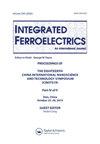Simple Method for Enhancing Performance of the Bacterial Cellulose-Based Triboelectric Nanogenerator by Adding Conductive Interlayer
IF 0.7
4区 工程技术
Q4 ENGINEERING, ELECTRICAL & ELECTRONIC
引用次数: 0
Abstract
AbstractSurface charge density is a key factor that greatly enhances the performance of a natural-based triboelectric nanogenerator (TENG), which is essential for future sustainable sensing and harvesting devices. This work introduced a conductive interlayer between a main frictional layer and electrode. This approach can suppress the charge recombination rate and improve the amount of charges produced during the triboelectrification process. Bacterial cellulose (BC) film was selected as a main frictional layer for the TENG. A conductive nanomaterial, i.e. silver flake, was incorporated into the BC film as an intermediate layer for enhancing TENG performance. As firstly reported, the maximum electrical outputs for the multi-layer BC structure could be found when using silver flake/BC composite (ratio 1:5) as an intermediate layer, which has 122 V and 8.2 µA of output voltage and current, respectively. This is higher than the output voltage and current of a single layer BC TENG by approximately 3 and 8 times, respectively. The maximum output power of ∼440 µW is achieved by connecting with a load resistor of ∼10 MΩ. This demonstrates an efficient strategy for designing a high performance energy harvester by adding an intermediate layer for the target of practical purposes in sustainable systems.Keywords: Bacterial cellulose paperconductive nanofillerIntermediate layerTriboelectric nanogeneratorPerformance AcknowledgmentsThe authors gratefully acknowledge Miss Sasithorn Supaket and Miss Sasiwimon Siripongaporn for their assistance in BC and BC composite synthesis.Disclosure StatementNo potential conflict of interest was reported by the author(s).Additional informationFundingThis work was supported financially by KMITL under Grant No. KREF116501. The work of S. Sriphan was funded by King Mongkut’s University of Technology North Bangkok, Contract no. KMUTNB-65-KNOW-05. The work of T. Bongkarn was supported by Naresuan University (NU) and National Science, Research and Innovation Fund (NSRF) with Grant No. R2566B002.添加导电中间层提高细菌纤维素基摩擦电纳米发电机性能的简单方法
摘要表面电荷密度是提高天然摩擦电纳米发电机(TENG)性能的关键因素,是未来可持续传感和收获装置的关键。这项工作在主摩擦层和电极之间引入了导电中间层。这种方法可以抑制电荷复合速率,提高摩擦电过程中产生的电荷量。选择细菌纤维素(BC)膜作为TENG的主要摩擦层。在BC薄膜中加入导电纳米材料银片作为中间层,以增强TENG性能。如前所述,当使用银片/BC复合材料(比例为1:5)作为中间层时,多层BC结构的最大电输出分别为122 V和8.2µA输出电压和电流。这比单层BC TENG的输出电压和电流分别高出约3倍和8倍。最大输出功率为~ 440µW,通过连接负载电阻~ 10 MΩ实现。这证明了通过在可持续系统中为实际目的添加中间层来设计高性能能量收集器的有效策略。关键词:细菌纤维素纸导电纳米填料;中间层;摩擦电纳米发电机;性能感谢Miss Sasithorn Supaket和Miss Sasiwimon Siripongaporn对BC和BC复合材料合成的帮助。披露声明作者未报告潜在的利益冲突。本研究由KMITL资助,批准号:KREF116501。S. Sriphan的工作由King Mongkut 's University of Technology North Bangkok资助,合约编号:kmutnb - 65 - 05。T. Bongkarn的工作得到了那理大学(NU)和国家科学研究与创新基金(NSRF)的支持,批准号为:R2566B002。
本文章由计算机程序翻译,如有差异,请以英文原文为准。
求助全文
约1分钟内获得全文
求助全文
来源期刊

Integrated Ferroelectrics
工程技术-工程:电子与电气
CiteScore
1.40
自引率
0.00%
发文量
179
审稿时长
3 months
期刊介绍:
Integrated Ferroelectrics provides an international, interdisciplinary forum for electronic engineers and physicists as well as process and systems engineers, ceramicists, and chemists who are involved in research, design, development, manufacturing and utilization of integrated ferroelectric devices. Such devices unite ferroelectric films and semiconductor integrated circuit chips. The result is a new family of electronic devices, which combine the unique nonvolatile memory, pyroelectric, piezoelectric, photorefractive, radiation-hard, acoustic and/or dielectric properties of ferroelectric materials with the dynamic memory, logic and/or amplification properties and miniaturization and low-cost advantages of semiconductor i.c. technology.
 求助内容:
求助内容: 应助结果提醒方式:
应助结果提醒方式:


